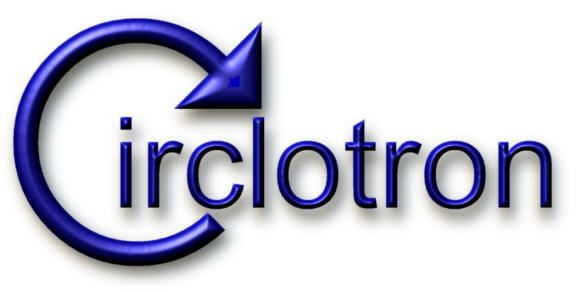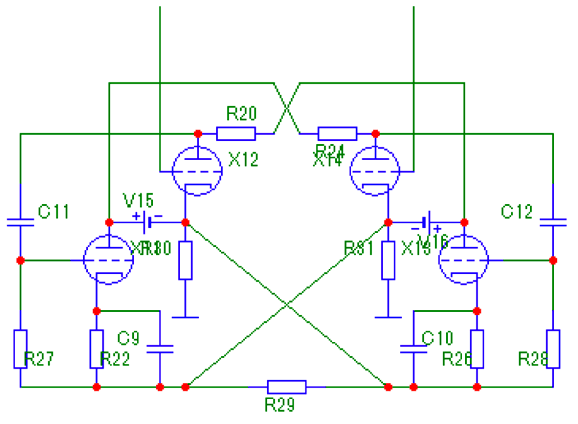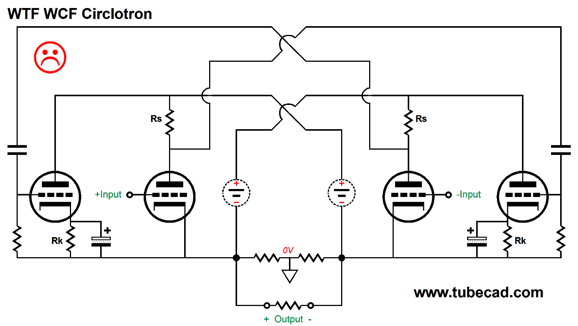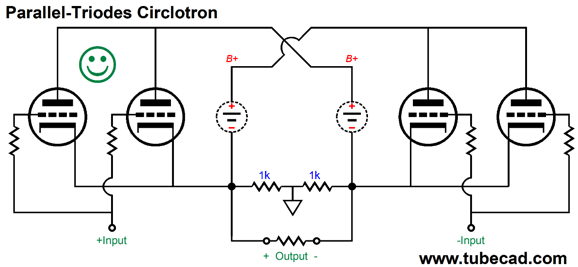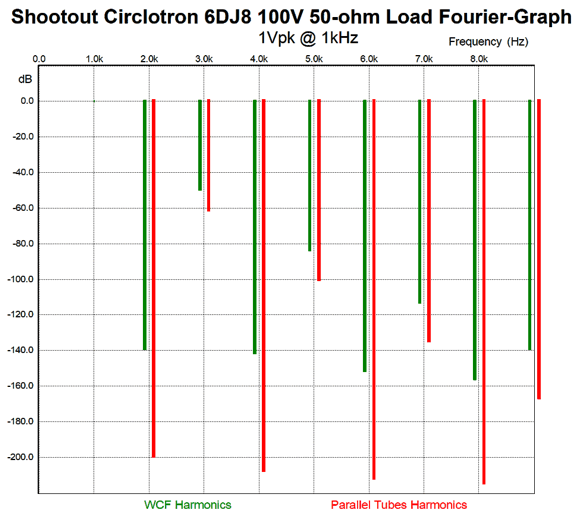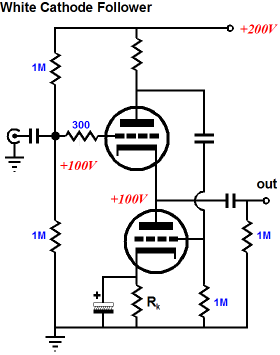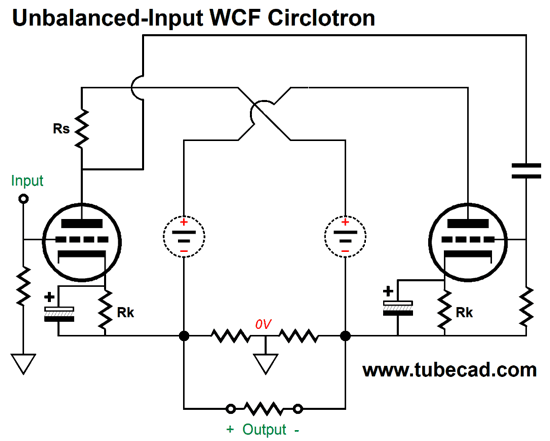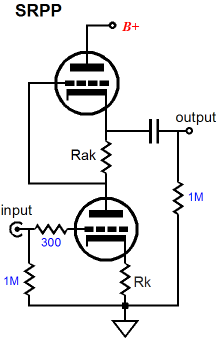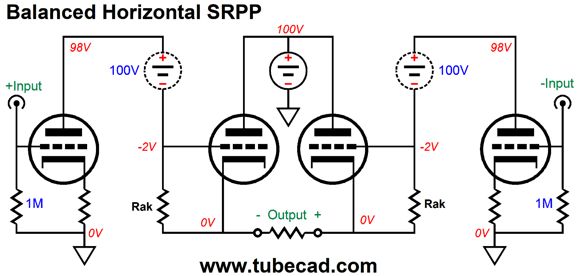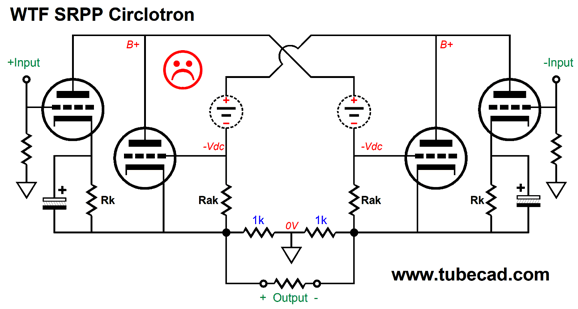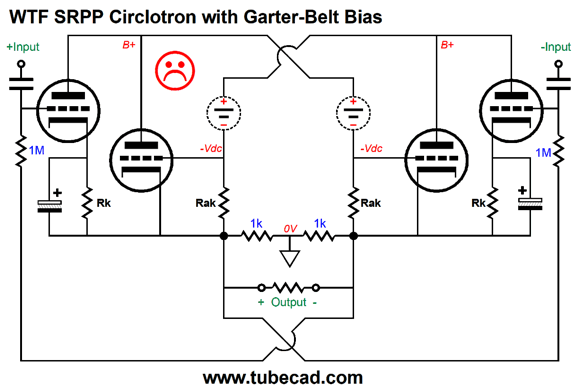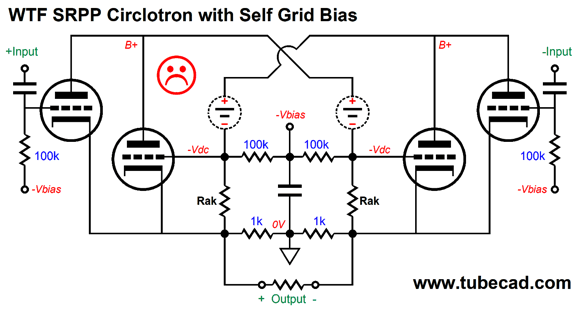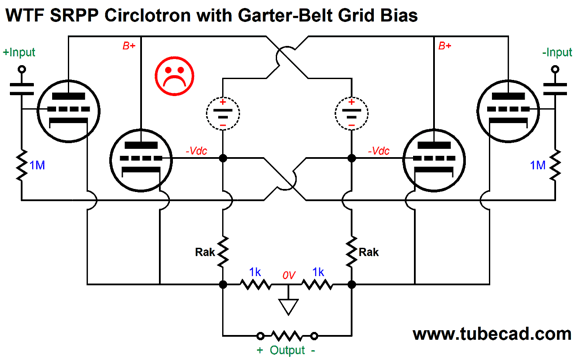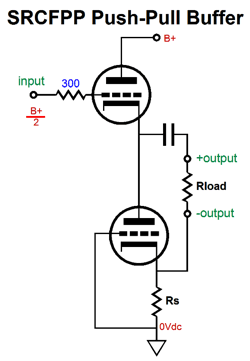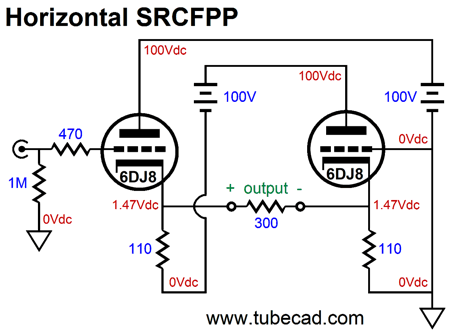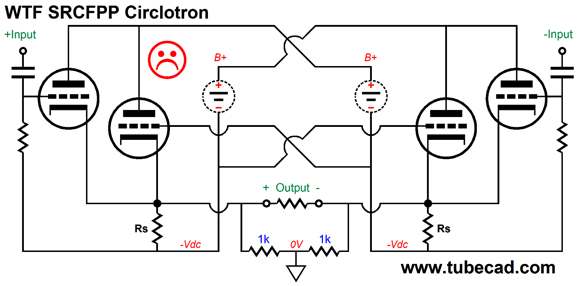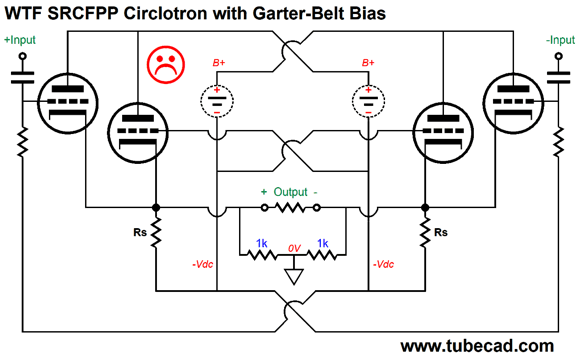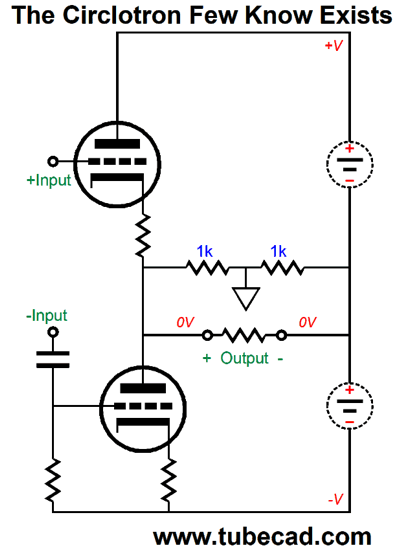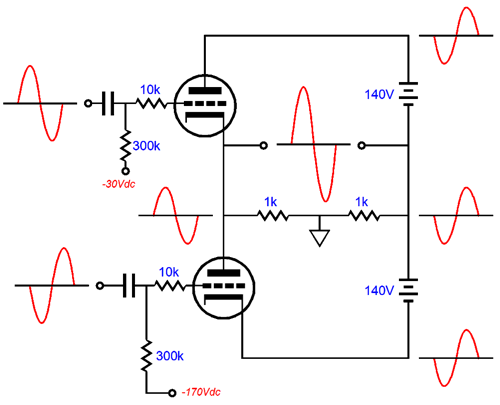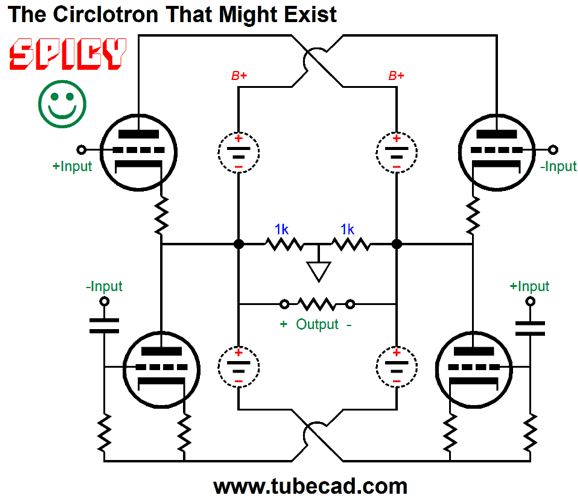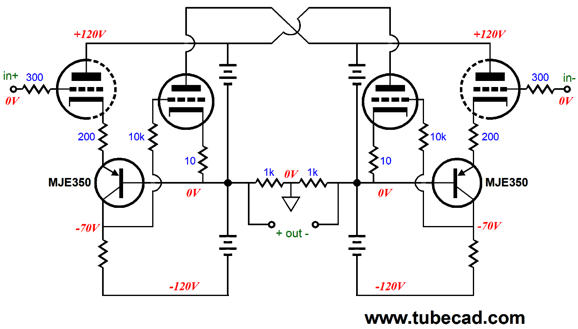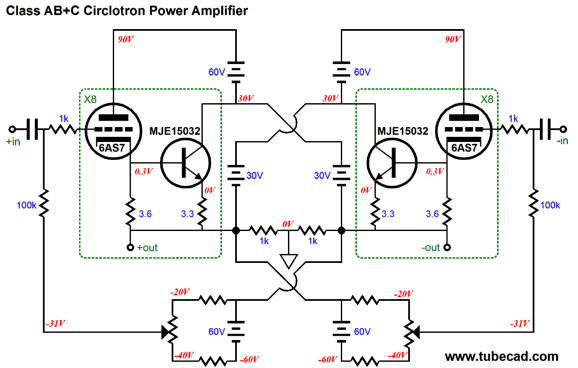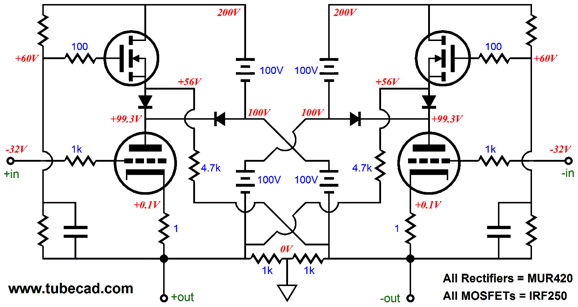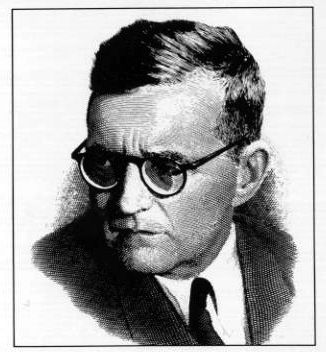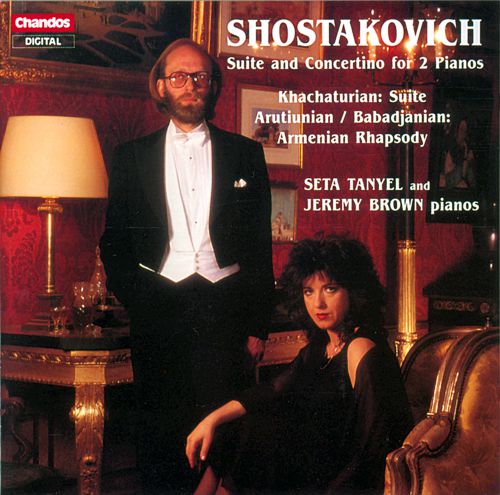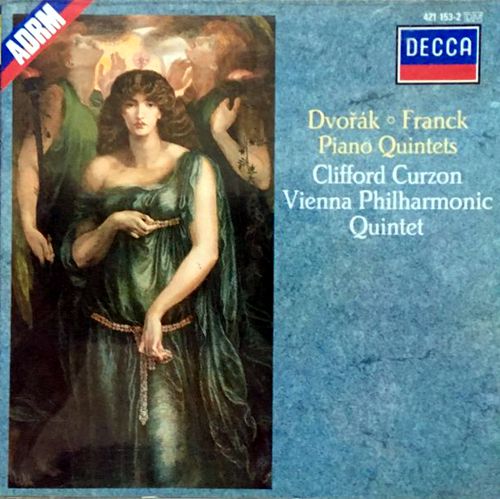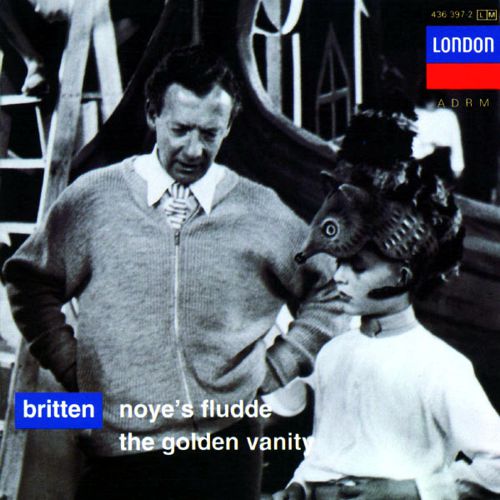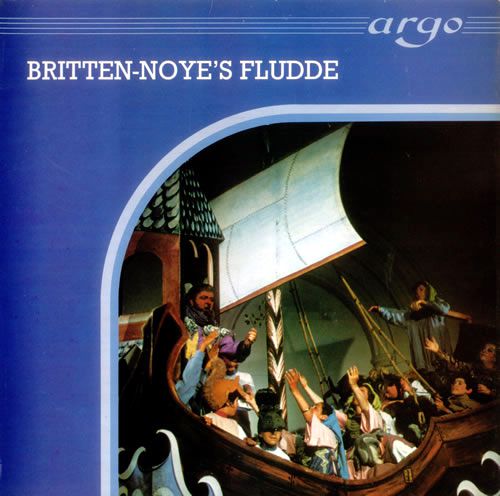| John Broskie's Guide to Tube Circuit Analysis & Design |
|
13 June 2018 Post 428
Much like those pictures that admit two different interpretations, such as either a two mirrored faces or a vase, this schematic instantly made sense and then it completely eluded my comprehension. The solution—the solution I always employ with a circuit that I don't understand—was to redraw the schematic on paper. Paper beats not only rocks (and scissors) but just anything else when it comes to understanding something new. I love paper—and pencils, my favorite being the TUL mechanical pencil sold at Office Depot.
In addition, when I get stuck while programming, I resort to pseudo code on paper. And on those rare occasions when I encounter some truly fine essay on the web, I acknowledge and reward its fineness by printing it on paper, so I can read it on paper, not pixels. Alas, not everyone shares my passion for paper. For example, I have learned never to ask my wife to buy me a new drawing pad, as she will hunt down the cheapest pad, not the best pad for drawing schematics. At the same time, too fine a pad proves—paradoxically enough—also unsuitable for schematic drawings. I know this from experience, as I once bought a pad filled with extra-fine, calligraphy-grade paper, a paper so elegant and valuable that I dared not blemish any of it with my hasty pencil markings. Okay, back to circuits, here is my redrawing of the schematic.
Now, I have zero problems with seeing what schematic contains. In fact, it brought back memories of this circuit that I showed in 2000 in an article on horizontal layouts of well-known tube circuits.
Shown above is a horizontal White cathode follower. Now, if we take two of these circuits and place them in a mirrored arrangement, then superimpose them upon the same output load impedance, we get the same White cathode follower circlotron. In fact, if you hunt down all of my horizontal translations and my many split-load translations of common tube circuits, you can readily make circlotrons out of them. Okay, returning to this new circlotron, I have boldly and rudely labeled this circuit with the epigraph, WTF White cathode follower Circlotron. WTF?
I know Nick Armstrong of WTF Marketing. He is a supremely nice guy, so I am always shocked when I visit his website, littered as it is with words, like "f*ck" and "sh*t." Plumbers, whose work warrant, no less than marketing, the words "f*ck" and "sh*t," abstain from their display on their websites. Then there is wtfamps.com, which I was relieved to discover stood for Wauwatosa Tube Factory. (By the way, be sure to check out Tim Cose's website and his Patreon.) As Phil Dunphy would say and as I say, Why The Face? In this case, a sad face.
The WTF WCF circlotron works; nothing blows up; all the cathodes are situated a ground potential at idle, which is a plus; but we must ask ourselves the question asked by all soldiers after a ten-mile hike, "Was this trip really necessary?" In other words, does this elaborate variation the circlotron give us anything more than we would get with the following circlotron that uses the same number of triodes?
NTF, which stands for Note The Face. In this case, a happy face. This double-barrel circlotron also works; nothing blows up; all the cathodes are situated a ground potential at idle; fewer parts are needed; and the performance is better.
The SPICE-generated Fourier graph clearly shows which variation is the winner. Okay, great, but why does the simple parallel version win? To arrive at the answer we must look into how the White cathode follower works. The White cathode follower is one of the trinity of lazy push-pull amplifiers, which includes the SRPP and SRCFPP topologies. Each of this topologies work in the same fundamental way: an anti-phase signal is created by sensing the current flow through a resistor that is placed in series with the input triode and the load impedance. The secondary triode then sees this internally-created anti-phase signal, which prompts its anti-phase current conduction to the primary triode.
In contrast, the other push-pull output stages, such as the circlotron, the totem-pole, and the conventional transformer-coupled output stage, all have their balanced input signals delivered by the signal source itself or created by a phase splitter. Thus, since the circlotron must be driven by a balanced input signal, why are we needlessly duplicating a balanced signal that is neither as distortion-free nor as power-supply-noise-free as the original input signal? It is like paying for something that you get free, but worse, as the very act of paying ends up adding distortion and noise. On the other hand, if the input signal is not balanced, then we could make horizontal White cathode follower and let the ground fall mid load, creating a circlotron-like circuit.
This split-load, horizontal White cathode follower is no less lazy than the conventional White cathode follower, but it does offer two advantages: no coupling capacitors and the two cathodes are at ground potential at idle. The big disadvantage is having to supply two floating power supplies per channel. I mentioned a trinity of lazy push-pull circuits, so can we make circlotrons out of the SRPP and the SRCFPP? We could, but we run right back into the problem needlessly duplicating and sullying the balanced input signal. Nonetheless, I will show you how to do so. Why? First, it will save others the effort of doing so and them from believing that they have created something better than the parallel circlotron. Second, examining these topologies will show how a mono-polar floating power supply can create bipolar power-supply rails. Let's start with the SRPP.
The next step is to go horizontal.
Note the -2V. Then we duplicate and mirror.
And the last step is to combine and eliminate the redundant fixed power supply, which leaves us with a balanced SRPP circuit.
This actually an interesting circuit in itself. Note how the balanced outputs are at ground potential and how the two floating power supplies create two negative voltages. Our last step is to further combine and eliminate until we end up with an SRPP circlotron
Once again, WTF, note the sad face, as this circuit cannot outperform the parallel-triode circlotron. While you are at it, note that the input triode grid resistors terminate into ground. The better way is to use a garter-belt crisscross arrangement.
Why is this better? It self corrects imbalances in the output DC voltages. If one side goes to positive, the other side must go too negative, due to the ground being located mid load. But with the garter-belt setup, each side receives a correcting DC signal and the imbalance grows smaller. While we are at it, note the cathode resistors and their bypass capacitors. We can eliminate them altogether.
What about the garter-belt arrangement? We can easily make this transformation, as shown below.
The last lazy push-pull circuit is the SRCFPP, which stands for Single-Ended Reflexive Cathode Follower Push Pull. I wish I had left the "cathode" out of the name, as this topology can use other active devices, such as MOSFETs and transistors.
Once again, the first step to creating a circlotron out of this circuit is to horizontal.
The next step is to duplicate and flip and then combine.
Note how few coupling capacitors there are and how the outputs are at ground potential. Since we know how to apply the garter-belt arrangement, we might as well apply to this SRCFPP circlotron.
This circuit, like all the previous circuits, wears the WTF icon of shame, as it, alike all the previous circuits cannot outperform the parallel-triode circlotron. Okay, what if we give up on the lazy push-pull circuits and just use the preexisting balanced input signal, but double up on the triodes without placing them in parallel? Here is where we start.
Very few know that this version following the circlotron exists. Many will assume that is a conventional totem-pole topology with a bipolar power supply. It looks like one, but it isn't one. Note where the ground falls and that both voltage sources are floating. In addition, both top and bottom triode must see equal amplitude input signals, which of course differ in phase. in other words, we do not need to modify a phase splitter so that can can deliver dissimilar amplitudes.
To read more about this variation on the circlotron, see post 340 and my Cars, Planes, and Circlotron PDF. To convert this variation into a double-barrel version is easy enough.
This variation will perform as well but not better than the parallel-triode version—in SPICE; thus, the SPICY badge. In reality, we face the problem of a worse PSRR, as the bottom voltage rails will contain power-supply noise (as will the top power-supply rails), but as the balanced input signal delivered to the bottom triodes will be free of the negative rail power-supply noise, the noise will needlessly mix with the signal applied to the bottom triode grids. As long as the output stage is still running a its class-A window of operation, the noise will tend to cancel at the output. But once the output stage leave class-A and enters class-B, the power-supply noise will suddenly appear superimposed on the output signal. Considering that this variation require twice the floating power supplies and must deliver a worse PSRR, I cannot see any advantage in using it in the parallel-triode circlotron's stead.
Speaking of class-A, the circuit shown above can be run in class-B, class-AB, and class-A. In contrast, all of the circlotrons based on lazy push-pull amplifier topologies must be run in pure class-A. Why? The current-sense resistor only develops a drive signal while some current flows through it. No current, no signal. And no current is what we get when the output stage leaves class-A and half the triodes turn off completely.
The input triodes control the output triodes. This bastode or retrograde cascode topology result in a lot of open-loop gain, which in turn results in lots of negative feedback. In other words, the input triode exercise an extremely tight grip on the output triodes. Note the absence of coupling capacitors.
No solid-state devices to be seen, other than one diode. The two cathode-coupled amplifiers control the output triodes and correct departures from their input signal. The differential amplifier input stage just provides gain to the balanced input signals. Speaking of class-AB, the triodes in a circlotron output stage will suffer from the same gm-doubling distortion that solid-state devices give rise to in class-AB amplifiers. While all the output tubes are conducting, the output stage exhibits twice the gm that it will once half the output tubes cutoff. The workaround is to add a set of class-C output devices. Class-C means cutoff, no conduction, at idle.
Note the 30V floating power supplies and the 60V power supplies. At idle, the NPN transistor are completely turned off; they only turn on when the triodes on the opposing side shut off. If the listening level is low, they may never turn on. The trick is to set the 6AS7's cathode voltage to half of the NPN transistor's turn on voltage. Thus, when on triode doubles it current flow, the other triode will have turned off and the class-C transistor will see enough base-to-emitter voltage to turn on and deliver the missing transconductance. The result is a constant gm, which is what a true class-A amplifier also achieves. Also note the garter-belt bias arrangement. See post 318, for a more detailed explanation. Another enhancement to the straight circlotron would to go class-G, so that output tubes cathode-to-plate voltage cannot fall below preset limit.
See post 287 for the complete explanation.
Music Recommendations, Classical Favs
I know that he isn't everyone's cup of tea, but love Demitri Shostakovich (1906 - 1975), the late great Russian composer. He famously said, "If they cut off both hands, I will compose music anyway holding the pen in my teeth." Which I echo by saying, "If they cut off both hands, I will draw schematics anyway holding the pencil in my teeth." Many know the story of how he had been the darling composer in the Soviet Union, until Stalin gave him a bad review on his opera, Lady MacBeth of the Mtsensk District (1936). Now some bad reviews are worse than others. A really bad review from Joseph Stalin could get you shot; a slightly less bad review could send you off to the Gulag. Jazz was officially banned in 1932; Tchaikovsky was renounced; too White Russian, he was deemed, although he died in 1893. The Soviet Union needed a nationalist composer and Shostakovich had been seen as the Tchaikovsky replacement, which he was briefly. The problem was that the communist had delivered utopia and anyone who wasn't happy was obviously not only ungrateful, but seditious. Lady MacBeth was not a happy show tune. Most know him for his Fifth Symphony, which sounds quite Mahler inspired and not so happy, but more struggling and somber, and which the Soviet press described as “a Soviet artist’s reply to just criticism.” Fortunately for Shostakovich, World War Two started soon after and Russians could go back to being morose, without government censure. I own two books that claim to hold the Shostakovich's memoirs; the first, Testimony, was published in 1979 and edited and smuggled out of the USRR by Solomon Volkov. The second was published in the USSR and was obviously written by hacks in the Politburo; in addition, its paper is that substance that passed for paper in the USRR, only surpassed in ickiness by Soviet-era cardboard. Still, it's fun to hold them side by side and read two diametrically opposed stories. Okay, the CD that I have gifted most is a Chandos recording of Shostakovich's Suite and Concerto for Two Pianos in F sharp minor, Op. 6. Seta Tanyel and Jeremy Brown play piano and the music breathtaking. Note the opus number 6; Shostakovich was 15 or 16 when he composed the piece after the death of his beloved father.
I find the those who claim to not like classical music, usually love this piece. The second CD that I have given the most is Arvo Pärt's, Tabula Rasa, on the ECM label (ECM New Series – ECM 1275). It was released in 1984, but I didn't hear it until five years later. I was hooked for life. I instantly fell in love with his Cantus in Memory of Benjamin Britten. I also love Britten, so anything in memory of him would catch my eye and ear.
Keith Jarrett on piano and twelve cellists from Berlin Philharmonic Orchestra are just some the players on this CD. My third favorite give away is going to be a hard sell, as I know that it will have to fight to win ears and hearts. Nonetheless, the Vienna Philharmonic Quartet and Clifford Curzon performing Dvorak's Piano Quintet Op.81 is too lovely not to list.
My last favorite is one-act opera by the British composer Benjamin Britten, Noye's Fludde (Noah's Flood).
I have actually given this CD—and to non-classical-music types. Why? The sound. On a truly good system, you can hear the size of the performance hall, even when no music is sounding, as the almost sub-audible sounds of children's feet shuffling along allow our brains to calculate the room's size. Okay, it is a stereo-demo recording of sorts, much as Hamlet is mystery play. This is grand music that was composed for amateur performers (the children choir could hardly be made up of old veterans). Sung in English and with story we all know, few will get lost; but more than a few will find themselves falling in love with the music. In fact, during stereo shootouts, this CD has played on and on, as we were all loathe to switch to another CD. If at all possible, track down the Argo LP, which sounds far better than the CD.
There is even a Japanese remastered, K2HD 24-bit 100 kHz, version of the CD, which I have never seen, let alone heard. Okay, how useful will Tidal be this time with these Albums? As hardly bears repeating, Tidal sucks when it comes to classical music, having zero sense about composers, compositions, conductors, and performing artists. Classical music is not Country, it's not Rap, it's not Hip-Hop, it's not Pop; it is classical music. Thus, finding a certain composition is needlessly difficult. To find the Shostakovich Suite for Two Pianos, search Tidal for Seta Tanyel. To find Arvo Pärt Tabula Rasa, you cannot type in "Tabula Rasa" or "Arvo Pärt," oddly enough (or is it insanely enough?); instead, you must type exactly, "Arvo Pärt Tabula Rasa". By the way, Tidal offers the ECM MQA version, a must hear. To hear Clifford Curzon performing Dvorak's Piano Quintet Op.81, search Clifford Curzon and you will find an album with Dvorak's 8th symphony and the Quintet played with the LPO. To hear Britten's Noye's Fludde, search for "noye's fludde." Happy listening. //JRB
User Guides for GlassWare Software
For those of you who still have old computers running Windows XP (32-bit) or any other Windows 32-bit OS, I have setup the download availability of my old old standards: Tube CAD, SE Amp CAD, and Audio Gadgets. The downloads are at the GlassWare-Yahoo store and the price is only $9.95 for each program. http://glass-ware.stores.yahoo.net/adsoffromgla.html So many have asked that I had to do it. WARNING: THESE THREE PROGRAMS WILL NOT RUN UNDER VISTA 64-Bit or WINDOWS 7 & 8 or any other 64-bit OS. I do plan on remaking all of these programs into 64-bit versions, but it will be a huge ordeal, as programming requires vast chunks of noise-free time, something very rare with children running about. Ideally, I would love to come out with versions that run on iPads and Android-OS tablets.
//JRB
|
|
John Gives
Special Thanks to the Special 69!
I am truly stunned and appreciative of their support. In addition I want to thank
All of your support makes a big difference. I would love to arrive at the point where creating my posts was my top priority of the day, not something that I have to steal time from other obligations to do. The more support I get, the higher up these posts move up in deserving attention. Only those who have produced a technical white paper or written an article on electronics know just how much time and effort is required to produce one of my posts, as novel circuits must be created, SPICE simulations must be run, schematics must be drawn, and thousands of words must be written. If you have been reading my posts, you know that my lifetime goal is reaching post 1,000. I have 572 more to go. My second goal is to gather 1,000 patrons. I have 931 patrons to go. Help me get there.
Only $12.95 TCJ My-Stock DB
Version 2 Improvements *User definable Download for www.glass-ware.com |
||
| www.tubecad.com Copyright © 1999-2018 GlassWare All Rights Reserved |
